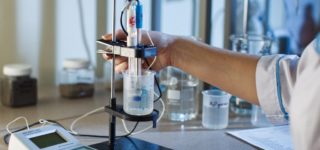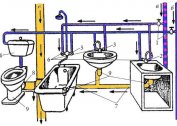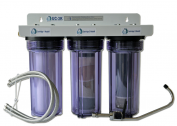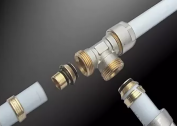When planning a water supply system that provides drinking water from a well at home, it is important to perform laboratory analysis. It will help determine if the liquid from the source is suitable for drinking and cooking, as well as which filter you need to install to improve its quality. In SES, the cost of analyzing water from a well allows you to conduct such procedures regularly, but in different regions it differs.
Assignment of different types of analyzes
Laboratory analysis is performed only 2-3 weeks after the construction of the well and its use. It is not necessary to drink water at this time, but you can use it for watering, domestic purposes. Each type of diagnosis detects different impurities and substances.
Chemical diagnostics
With the help of chemical analysis, it is possible to identify impurities that, with regular penetration into the human body, can be deposited in organs and adversely affect health. With its help determine the concentration of salts, minerals and other trace elements in the composition of the liquid.
Chemical diagnostics allows you to determine the degree of purification needed by the water from the source, as well as at what depth the layer of certain trace elements is concentrated. Using this method, you can understand how often diagnostics are needed. In some places, experts advise conducting it every month due to changes in liquid levels in shallow wells.
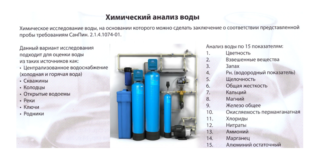 To direct the fluid to the diagnosis, it must first be properly collected:
To direct the fluid to the diagnosis, it must first be properly collected:
- Within 4-8 hours, the well is pumped.
- They collect water in cleaned plastic bottles, but do not use chemicals for washing, as they will affect the result.
- Remove excess air from the bottle, squeezing it on the sides, then twist it and place it in a dark bag.
The owner of the well has 36 hours to deliver the sample to the laboratory. Be sure to mark the date of collection, year, exact time and location on the bottle.
Bacteriological analysis
 This diagnostic method is also important because it determines the presence of dangerous infections and bacteria in the well. With it, you can understand why microorganisms appeared in the well:
This diagnostic method is also important because it determines the presence of dangerous infections and bacteria in the well. With it, you can understand why microorganisms appeared in the well:
- due to rising groundwater;
- as a result of infection with feces of animals or people;
- due to the penetration of rain and melt water passing through dirty soil;
- due to the penetration of rotting particles;
- as a result of a deterioration in the overall quality of water in the nearest body of water.
For diagnosis of bacteriological infection, the rules for collecting water are different.
It is necessary to prepare a sterile glass container, plastic bottles will not work. You can buy containers at the pharmacy or go to the laboratory. You can also steam sterilize the bottle at home.
Water is drawn through a hose or faucet, the tip of which is burned to eliminate surface bacteria. The liquid must first drain for at least 7 minutes. The resulting sample is tightly closed with a lid, put away in a bag, mark the date, time and place of collection.
Microbiological diagnosis
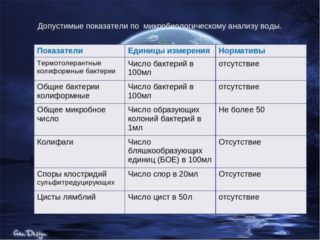 A more accurate view of the study of water in the well, aimed at clarifying the content of microorganisms. With its help you can identify:
A more accurate view of the study of water in the well, aimed at clarifying the content of microorganisms. With its help you can identify:
- hydrobiological and microbiological indicators;
- the presence of helminths and bacteria;
- the presence of viruses and molecules of intestinal diseases;
- the content of other microorganisms.
A sterilized glass bottle is required for collection. Submit water for analysis within 24 hours after receipt.
Water quality indicators
Chemical quality analysis is carried out in accordance with SanPiN 2.1.4.1074-01. The results are presented in the form of a table, the nature of the smell (odorless, rotten, putrid, sour) is separately noted.

Microbiological analysis indicates how many microbes are contained in the water (per unit volume should be no more than 50 units of bacteria). Thermo-tolerant microorganisms that are dangerous to humans are also determined. Quality water contains 0 such parasites. The next indicator is coliform bacteria, indicating fecal contamination. It should also be 0.
It is necessary to conduct microbiological diagnostics with a chemical one in cases when the well depth is less than 10 m. Also, experts check the content of detergent chemistry and oil products in the water.
Where are the diagnostics performed?
You can order chemical and bacteriological analysis in the sanitary-epidemiological surveillance service, as well as in a private laboratory. Prices for testing water from a well for drinking in government agencies may be higher. Also involved in the diagnosis: Vodokanal Laboratory, Rospotrebnadzor.
Procedure cost
The average price of a full diagnosis is in the range of 2500-3000 rubles. Analysis of biological indicators will cost less - no more than 2000 rubles.
Features of checking at home
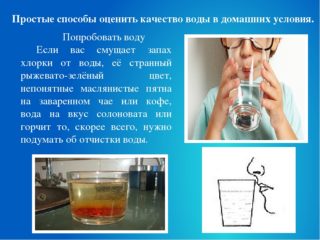 Diagnosing water at home is not as effective as in a laboratory. However, you can check the initial state of the fluid. Among the methods of checking water from a well at home for quality, there are:
Diagnosing water at home is not as effective as in a laboratory. However, you can check the initial state of the fluid. Among the methods of checking water from a well at home for quality, there are:
- Determination of taste and smell. Water is poured into a glass heated to 20-25 degrees, in another - up to 60 degrees. The smell and taste of the liquid should be absent, as well as the specific sensations when consumed: bitterness, tweaking of the tongue.
- Rigidity. The water is boiled and left to cool completely. A white precipitate appears in a hard liquid; the larger it is, the higher the stiffness indicator.
- Brewing strong tea. After boiling, tea is brewed, a little pharmacy water without minerals is added to it. If the liquid becomes turbid, it means that well water contains impurities after filtration.
- Test bottle. Water is collected in a plastic bottle and put in a dark place for 48 hours. If plaque, oil film or liquid turns green, this indicates a large amount of impurities.
- Manganese solution. A crystal of substance is added to the water. If the liquid turns yellow, you should not drink it.
However, none of these methods can give an accurate analysis of the content of iron, calcium and other trace elements in the well fluid.
Home diagnostic methods are usually performed after the installation of filter systems. Testing water directly from the well at this stage may not be informative.
Check Frequency
The minimum number of inspections per year is 1, but sometimes experts recommend taking samples 2-3 times a year. This is especially true when revealing a large number of polluting particles, as well as with a small depth of the well - up to 10 m.
It is important to perform water analysis for chemical and bacteriological indicators regularly, and not once after the construction of a well. The state of health of all family members depends on this. When drinking low-quality water, the body does not receive the necessary trace elements and is susceptible to infection or intoxication.
